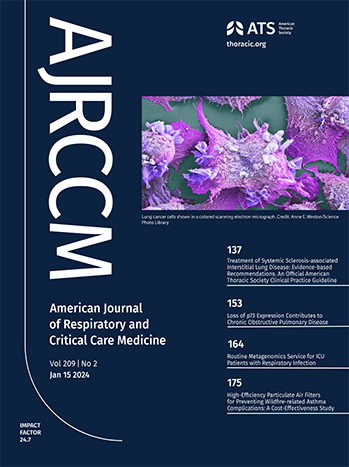Mucus Plugs Correlate with Small Airway Remodelling in Asthma: A Case-Control Study.
IF 19.4
1区 医学
Q1 CRITICAL CARE MEDICINE
American journal of respiratory and critical care medicine
Pub Date : 2025-08-22
DOI:10.1164/rccm.202501-0310oc
引用次数: 0
Abstract
RATIONALE The observation that mucus plugs in proximal airways on computed tomography (CT) correlate with disease severity and airflow obstruction has highlighted their role in asthma. Due to the resolution of CT, it is unknown if mucus plugs within the distal small airways (<2mm in diameter) also contribute to asthma severity. OBJECTIVES To assess the prevalence of distal mucus plugs and their association with small airway remodelling in asthma. METHODS 12 control, 5 non-fatal, and 11 fatal asthma lungs underwent systematic uniform random sampling to obtain 239 lung tissue samples that were imaged using micro-CT and matched histology to assess mucus plugs, airway wall remodelling and mucus composition. MAIN RESULTS Within the distal lung of non-fatal and fatal asthmatics, 30% and 38% of pre-terminal bronchioles, 29% and 34% of terminal bronchioles, and 33% and 21% of transitional bronchioles contained mucus plugs, with a high coefficient of variation in their spatial location. Mucus plugs were comprised of 84% and 82% MUC5AC and 16% and 18% MUC5B in non-fatal and fatal asthma, and 67% extended over 80% of the bronchiole pathlength. In asthmatic lungs, mucus-plugged airways had thickened airway walls, narrowed airway lumens, and luminal folding compared to unplugged airways, due to increased epithelial, basement membrane, and smooth muscle thickening. CONCLUSION In asthma, mucus plugs are a prominent and spatially heterogeneous feature within the distal small airways, and are associated with airway wall remodelling and lumen narrowing, making them a key target for improving lung ventilation and patient outcomes.哮喘患者粘液塞与小气道重塑相关:一项病例对照研究
理由:在计算机断层扫描(CT)上观察到近端气道粘液塞与疾病严重程度和气流阻塞相关,强调了它们在哮喘中的作用。由于CT的分辨率,尚不清楚远端小气道(直径<2mm)内的粘液塞是否也与哮喘严重程度有关。目的评估哮喘患者远端粘液塞的患病率及其与小气道重塑的关系。方法系统均匀随机抽取12个对照组、5个非致死性哮喘肺和11个致死性哮喘肺,获得239个肺组织样本,使用显微ct和匹配组织学成像评估粘液塞、气道壁重塑和粘液成分。主要结果在非致死性和致死性哮喘患者的远端肺内,30%和38%的终末细支气管、29%和34%的终末细支气管、33%和21%的过渡性细支气管存在粘液塞,其空间位置变异系数高。在非致死性和致死性哮喘中,粘液塞分别由84%和82%的MUC5AC和16%和18%的MUC5B组成,67%的粘液塞延伸超过80%的细支气管路径长度。在哮喘肺中,由于上皮、基底膜和平滑肌增厚,与未堵塞的气道相比,粘液堵塞的气道气道壁增厚,气道管腔变窄,管腔折叠。结论在哮喘中,粘液塞是远端小气道内一个突出且空间异质性的特征,与气道壁重塑和管腔狭窄有关,是改善肺通气和患者预后的关键靶点。
本文章由计算机程序翻译,如有差异,请以英文原文为准。
求助全文
约1分钟内获得全文
求助全文
来源期刊
CiteScore
27.30
自引率
4.50%
发文量
1313
审稿时长
3-6 weeks
期刊介绍:
The American Journal of Respiratory and Critical Care Medicine focuses on human biology and disease, as well as animal studies that contribute to the understanding of pathophysiology and treatment of diseases that affect the respiratory system and critically ill patients. Papers that are solely or predominantly based in cell and molecular biology are published in the companion journal, the American Journal of Respiratory Cell and Molecular Biology. The Journal also seeks to publish clinical trials and outstanding review articles on areas of interest in several forms. The State-of-the-Art review is a treatise usually covering a broad field that brings bench research to the bedside. Shorter reviews are published as Critical Care Perspectives or Pulmonary Perspectives. These are generally focused on a more limited area and advance a concerted opinion about care for a specific process. Concise Clinical Reviews provide an evidence-based synthesis of the literature pertaining to topics of fundamental importance to the practice of pulmonary, critical care, and sleep medicine. Images providing advances or unusual contributions to the field are published as Images in Pulmonary, Critical Care, Sleep Medicine and the Sciences.
A recent trend and future direction of the Journal has been to include debates of a topical nature on issues of importance in pulmonary and critical care medicine and to the membership of the American Thoracic Society. Other recent changes have included encompassing works from the field of critical care medicine and the extension of the editorial governing of journal policy to colleagues outside of the United States of America. The focus and direction of the Journal is to establish an international forum for state-of-the-art respiratory and critical care medicine.

 求助内容:
求助内容: 应助结果提醒方式:
应助结果提醒方式:


